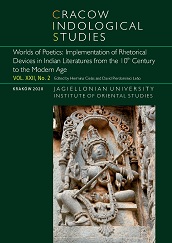A (Thin) Boundary Not to Be Crossed, or Lakṣmaṇ-rekhā
A (Thin) Boundary Not to Be Crossed, or Lakṣmaṇ-rekhā
Author(s): Danuta StasikSubject(s): Gender Studies, Studies of Literature, Ethics / Practical Philosophy, Indian Philosophy
Published by: KSIĘGARNIA AKADEMICKA Sp. z o.o.
Keywords: female chastity; Hindi literary tradition; North Indian ethos; Rāmāyaṇa; Rāmcaritmānas; Rāmcandrikā; Rādheśyām Rāmāyaṇ; Sūrsāgar; symbolic boundaries;
Summary/Abstract: This paper discusses the concept of lakṣmaṇ-rekhā that originates in the later Rāmāyaṇa tradition and for centuries has functioned as a metaphorical expression denoting a strict (moral) boundary that should not be crossed, as its transgression inevitably exposes one to danger. It has featured prominently in Indian public discourse on female chastity and is also very much present in different socio-cultural and political contexts, often vocalised in literature, works of art, etc. In the concept of lakṣmaṇ-rekhā, one of the most basic and at the same time most important functions performed in culture by symbolic boundaries is manifested-the function of delineating the known, familiar, safe and permissible from the unknown, unfamiliar, dangerous, impermissible. Significantly, these boundaries have inherent moral weight and help individuals as well as whole societies to structure and regulate the universe they live in, on the micro- and macro-scale. In this paper, first I discuss textual evidence that can be found in wellknown Hindi Rāmāyaṇas such as the Rāmcaritmānas, the Rāmcandrikā and Rādheśyām Rāmāyaṇ, as well as in the Sūrsāgar. This analysis of literary material is meant to contextualise various levels of explicit and implicit meanings of the concept of lakṣmaṇ-rekhā that emerge from traditional sources in Hindi. In the second part of this article, I offer a survey of relevant Hindi dictionary entries and then focus on modern non-literary (and not only Hindi) usages of lakṣmaṇ-rekhā. Finally, I place the previously examined literary and linguistic material in the context of the findings of contemporary social scientists on the concept of symbolic boundaries (Epstein 1992). It is hoped that this study that gives emphasis to structuring and regulating (but not only) aspect of boundaries can contribute to our understanding of how broadly understood safety and values are negotiated in contemporary Indian society by way of drawing (ethical) boundaries and what happens if they are compromised.
Journal: Cracow Indological Studies
- Issue Year: 21/2019
- Issue No: 2
- Page Range: 207-224
- Page Count: 18
- Language: English

